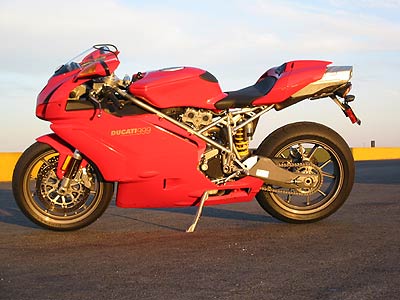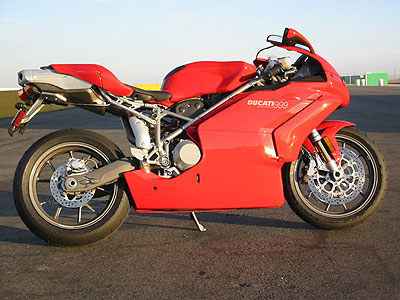Ducati 999 At Willow, Part 1
The 999 Part 1
“What do you think of the look?”

Beauty is in the eye of the beholder.
The question was posed to me from Ducati employees ranging in responsibilities from Media Relations to the CEO of Ducati North America. It’s a seemingly simple question but the posing of this question instead of “what do you think of the power?” or “how do you like the handling?” indicates how much Ducati has riding on the acceptance of the new fairing.
Same Paint, Different Year.
Ducati North America (DNA) is in a period of transition. They are closing their warehouse and corporate headquarters on the east coast and moving to the west coast. The geographic transition is requiring a huge turnover of employees who will not, or cannot, leave the east coast. DNA is also closing their warehouses and outsourcing their product distribution to two outside companies; one for parts, one for bikes. The controversial new CEO of DNA, Joe Piazza, comes to Ducati from the cruiser accessories market segment. And to cap it all off, after having the most evocative sportbikes in the decade, the Tamburini designed 916 and its successors, they are switching to the Pierre Terblanche designed 999.
“What do you think of the look?” indeed.
Beauty, of course, is in the eye of the beholder (that is not strictly true, some enterprising science geeks actually figured out the geometric algorithms for female facial beauty a few years ago but that is a different digression) and so I usually avoid expressing my personal opinions of the aesthetics of various motorcycles. If pressed, I will usually adopt a form follows function philosophy. If it works well, then its okay with me and the 999 is an extensively engineered motorcycle.
Maybe in 2010 we will talk about how we liked the look
of the old ones more again.
If you squint, you can see the genotype of the 916 lurking in the 999, but my first reaction is, I like the look of the 916 more. The cat eye headlights, the unadulterated expanses of red paint and two big muffler poking out the rear. It is still as eye catching today as it was ten years ago. An informal poll of associates has yet to find one person who likes the look of the 999 MORE than the 916-998s.
The “I like the old ones more” is just the sort of sentiment that Ducati is trying to discourage (although some conspiracy theorist suggest this is an “old coke” – “new coke” sort of thing, this theory has some credence since Ducati is still producing and marketing 998s in Europe but, at this time, DNA is not importing any more to the US) and the DNA party line is “I liked the 916 more in 2D but I like the 999 more in the 3D”.
The most common aesthetic complaints I’ve heard about the look of the new bike are:
- The muffler
- The things sticking out on the side of the leading edge of the fairing
- The stacked headlights
- Some folks complained about the wheels but I think they are just being picky.
Enter Andrea Forni, the chief testing engineer of Ducati. Andrea takes his job seriously. Every chance he got during the open track sessions at Willow Springs Andrea was suited up in Fogarty replica leathers and was doing an admirable job hustling a 999 with burned up Pirellis through Willow’s fast sweepers.
Andrea Forni delivered a detailed technical briefing on many of the changes from the 998 to the 999 including the frame, the fairing, the exhaust and the extremely advanced electrical system. In the course of an hour, and with no 999 in sight, Andrea unintentionally won me over to the some of the look of the Terblanche bike by explaining the engineering behind the design changes. (see The 999 –“On the Stand” in this issue) And, of course, the lines of the fairing and the styling of the muffler are irrelevant when you are bending a 999 into a 135 mph corner on your knee.
Following in the foot steps of the Tamburini bikes, the 999 feel impossibly small for a 1000. Ducati’s efforts to fit the rider closer to the center of the machine results in a gas tank so narrow it feels like your knees are practically touching. The ridge at the top hooks your high side knee perfectly and allows you to use thigh and stomach muscles to hold your weight instead of your arms through long sweeping turns.
The adjustable footpegs, in their “low position” feel too low and a little awkward for track use but their adjustable nature allows for easy repositioning to taste. The handlebars seem a little less race than their predecessor as well. These two changes alone made the bike feel a little more street than the 998. The handling of the bike is almost pure Ducati. Ducati’s always have a mid-corner feel that is basically unrivaled in motorcycling. The new bike has the same affinity for the apex and the slow turn-in that was a prior characteristic of earlier efforts is largely absent. The bike turns in lightly and, once committed, still offers the rider a wide variety of choices about increasing or decreasing the arc of the turn. The tiny feel of the bike only heightens rider confidence. If you can’t get your knee down off of a Ducati 9**, give up.
The seat is firm and flat. It is a perfect race perch although I would imagine it would not win any awards on long highway drones. The mirrors would be just as useless on the street as they are on the track.
The brakes are a huge improvement over the standard units fitted to the 998. They are, in fact, the calipers off the former “R” model and are the triple bridged (read: no flex) Brembos with four individual brake pads. Most stock brake pads are underwelming. These did not have the eye popping power of the HH rated pads of your choice but they were some of the best stock brakes I’ve felt. A pad swap would make them very impressive.
The hydraulic clutch gives good feel and the adjustable lever position allows you to quickly change the engagement point. The transmission is unremarkable, which, when you think about it, is really what you want in a transmission.
The motor is the familiar 90 degree Testastretta powerplant with Magneti Marelli fuel injection. The remarkable thing about the claimed 124 bhp (which I assume is measured at the crank) is the absolutely flat delivery of the power. For riders accustom to four cylinders there is a big period of adjustment. The first adjustment is that I often hit the 10,500rpm rev-limiter waiting for the top end power hit which never arrives and the second is that one can open the throttle earlier on the forgiving twin than on many comparably powered fours. It struck me as a bike which would be very hard to high side until the non standard Pirelli Corsas (the bikes ship with Michelin Pilot street tires which were deemed insufficient for Willow so Pirelli race tires were fitted instead) wore down a bit and the back end began to snap sideways on throttle. With worn tires the bike’s ample torque becomes much more noticeable and required judicial management.
The front Showa fork was very well damped (perhaps too much so) but it always gave firm and precise feedback. The rear shock was woefully under damped for any sporting motorcycle, much more so for one that costs $17,695. Even with the rebound adjuster all the way firm the bike was visibly too fast in the rear in the pits. On the track it would give an unpleasant oscillation over the undulations in Willow’s back straight which required easing off the throttle to let the suspension recover before throwing the bike into turn eight. This may or may not be noticeable on the street but it intruded on the refined and exquisitely engineered feel of the rest of the bike.
Despite the under damped rear shock, the whole bike quickly built confidence and, using the onboard lap timer, I found that I was running lap times within two seconds of our endurance race pace at the last 24-hour on a fully race prepped GSX-R600. Now, there are two way so to look at that. The first is to say that this street bike, in stock form, is almost as fast as a pure race bike, the other way is to say that a bike which costs thousands less is a bit faster.
Is the bike enjoyable? Absolutely. Are the engineering details intriguing? Without a doubt. Will you be the center of attention wherever you pull up? Certainly. Is it the fastest thing on two-wheels? No.
Those questions led me to different chain of thought. Who is going to buy this motorcycle?
Not racers. Few racers elected to contest Ducatis in the US and, those that are tempted to race a 999 will wait until the 999S is available with, for an extra $5,000, its Ohlins forks and shock, stronger cases and an additional 12 bhp. Few of the refinement of the 999 will be enticing to racers who currently own well developed Tamburini bikes and, with no contingency programs, there would be scant reason to update to one of these bikes. Since racers will not be purchasing many, if any, of these bikes, the stronger street focus starts to make more sense.
Seeming a little less exclusive.
The most Ducatis I’ve ever seen on a racetrack (besides a World Superbike grid) was at a track day. In that context I saw tens of $30,000+ Ducatis being carefully ridden around the track by a mostly middle aged group of Ducati enthusiasts and that is where I think this bike is squarely targeted. If you start thinking “track day bike for wealthy enthusiasts” the adjustable footpegs (street or track), the more comfortable ergonomics and softer suspension starts to make a lot of sense.
The Ducatis I saw at that track day were drenched with carbon fibre, expensive exhausts, trick suspension and, to hear the talk, motors with hot rod pistons, cams, clutches and chips. Since the lap times are not particularly relevant at track days most of the modifications to these bike were not done in such a manner to enhance the performance of the bikes but more in the time honored tradition of bike customization like chrome wheels, polished frames and fur covered fairings. Ducati is fully cognizant of this phenomena and encourages the personalization of their bikes by offering a gorgeous catalogue filled with magnesium and carbon bolt-ons (its impressive, wheels, clutches, swingarms, exhausts, all sorts of trick parts) for greater personal expression of their riders. But, at the heart of most of it, it is not about making the bike faster or more competitive, it is about making the bike more visually appealing, making the bike more of a style statement and making the bike more of a trophy. And so, Ducati is not particularly worried about power or weight or handling but: “What do you think of the look?”



